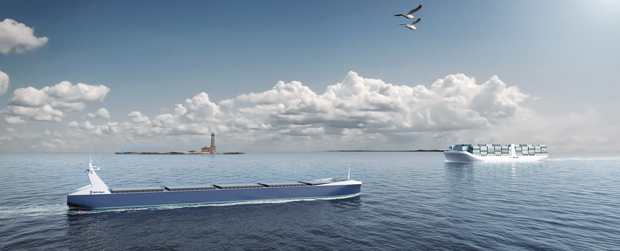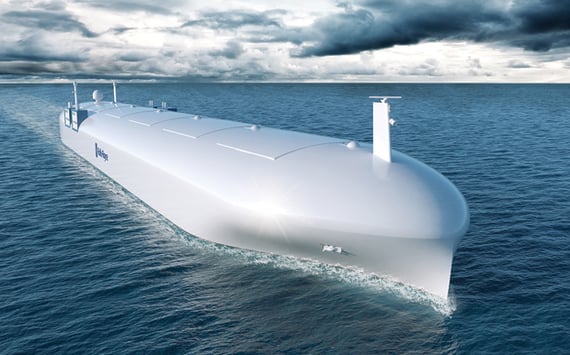REDWOOD LOGIN
Redwood PortalLTL
SCS
SCS Support
Rockfarm
Maritime shipping has remained generally the same over the past couple hundred years, but there is a new boat on the horizon that could revolutionize ocean transport – the “Robo-Boat.”
The Robo-Boat intends to be a fully automated cargo boat that will not require a single human being on the ship. A Robo-Boat will be able to monitor any issues with the ship that arise during transit, display what is in the water around it and make decisions based on the information it gathers by itself. The Robo-boat could be controlled remotely if anything happens and the ship was not able to function alone.
You might think this all sounds like a remote-controlled boat in a pool, and well, that is pretty much the premise behind it. Over the road trucking has multiple companies working on automated trucks that can drive with little human assistance if any at all. Maritime shipping is going the same route, but not without the challenges of actually getting a Robo-Boat in the water.
In this article, we will take a look at a Robo-Boat’s technology, how safe it is, the insurance for cargo on an unmanned ship and the timeline projections on when the Robo-Boat can get in the water.

Rolls-Royce is one of the pioneers in creating an automated ship for ocean cargo. According to Rolls-Royce, their three pillars in maritime shipping are sensor fusion, avoidance algorithms, as well as communication and connectivity.
Sensor fusion is already found in autonomous vehicles and already built into some safety features in cars on the road today. Putting this technology in a shipping vessel will give the ship’s controllers a clear picture of the immediate surroundings at all times. The main concerns about sensor fusion are the range in which the operators can control the sensors, and also how a storm at sea may alter sensor fusion’s effectiveness.
The name might not give away the idea of how important avoidance algorithms are, but in simplified terms, this is how a Robo-Boat would avoid collisions with anything floating in open water. These artificial decision processes would be put in place for the ship to decide by itself how to navigate depending on the information received from the fusion sensors.
Communication and connectivity will be crucial to the Robo-Boat’s success in the future because this allows a remote controller to regulate the boat itself without any delays. Communication needs to be as quick and accurate as possible to avoid poor navigation or to avoid the controller’s commands not getting through to the unmanned boat.
Before diving in, there will need to be regulations put in place allowing autonomous ships to operate. These Robo-Boats need to be at least as safe as the manned vessels currently in use now before having a chance of becoming the norm in maritime shipping. Outside of trying to control a ship in a storm remotely from thousands of miles away, the biggest threat to safety isn’t a physical threat – it is a cyber threat.
Cybersecurity is one of the biggest concerns for safety because it would now be possible for a hacker to take control of a ship carrying millions of dollars’ worth of cargo. At that point, they could direct the ship to a separate location or even set it adrift in the middle of the ocean. The Robo-Boat’s networks, hardware, databases, firewalls, and encryption would all need to be in exceptional standing before putting these boats into everyday use.

Regardless of what kind of shipping is used to transport cargo, accidents can happen and some product could be damaged. Most companies have to present a claim to their carrier’s insurance showing how the carrier damaged the cargo. If a Robo-Boat has damaged the product, one of the easiest statements to make to the insurance company is that no one was on board to ensure the product was being taken care of properly. This could be a major issue going forward for autonomous shipping.
Autonomous ships would likely force insurance companies to evolve and create some sort of insurance to cover cargo on an unmanned ship. If insurance companies are unwilling to bend, does that put a stop to a Robo-Boat, or does it go forward with increased liability? This is a question may end up above the insurance companies and autonomous ship manufacturers, and into the hands of the lawmakers.
As it stands, autonomous shipping is still in the infant stages. Manufacturers are still researching, developing and testing everything that would go into a Robo-Boat. Building an autonomous ship itself is not necessarily the challenge, but the technology, safety, and insurance needing to have clear-cut solutions currently stand in the way before an unmanned boat can hit the water.
According to Rolls-Royce, their plan for an unmanned ship is to develop an a Robo-Boat that can operate with a reduced crew to handle limited operations by 2020. The next step slated for 2025 is to have an unmanned, remote-controlled ship for small-scale trips. By 2030, Rolls-Royce would like to have an unmanned, remote-controlled ship hit the ocean for its maiden voyage. Finally, by 2035, they would like to have a completely autonomous Robo-Boat operating by itself with a controller only needed in case of emergency.
With all signs pointing towards a Robo-Boat of some kind coming, this will cause a major overhaul of maritime shipping as we know it. While aspects such as technology, safety, and insurance can prolong the process, expect to see some form of a Robo-Boat sailing the seven seas in the future.